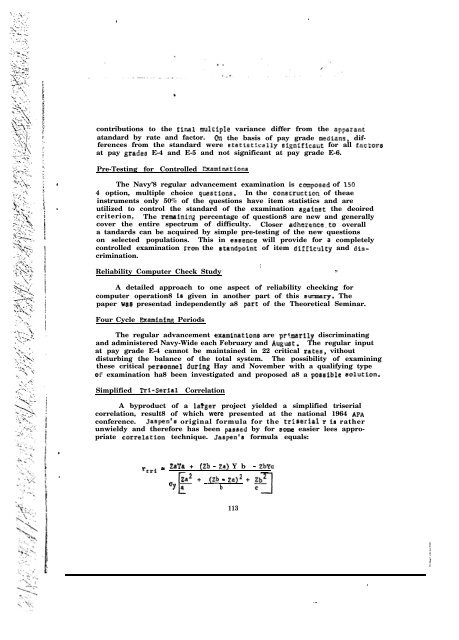Technical Report - International Military Testing Association
Technical Report - International Military Testing Association
Technical Report - International Military Testing Association
You also want an ePaper? Increase the reach of your titles
YUMPU automatically turns print PDFs into web optimized ePapers that Google loves.
.<br />
.<br />
.<br />
contributions to the fir&l mulctple variance differ from the apparant<br />
atandard by rate and factor. @n the basis of pay grade medfans, differences<br />
from the standard were etatistfcally significaut for all factor8<br />
at pay gradeo E-4 and E-5 and not significant at pay grade E-6.<br />
Pre-<strong>Testing</strong> for Controlled ~minations<br />
The Navy’8 regular advancement examination is compoeed of 150<br />
4 option, multiple choice questiors. In the construction of theae<br />
instruments only 50% of the questions have item statistics and are<br />
utilized to control the standard of the examination agalnat the deoired<br />
criterion, The remainfw percentage of question8 are new and generally<br />
cover the entire spectrum of difficulty. Closer adherrnce.to overall<br />
a tandards can be acquired by simple pre-testing of the new questions<br />
on selected populations. This in eesence will provide for a completely<br />
controlled examination from the standpoint of item difficulty and discrimination.<br />
Reliability Computer Check Study<br />
i<br />
7.<br />
A detailed approach to one aspect of reliability checking for<br />
computer operation8 ie given in another part of this surmary. The<br />
paper wa8 presentad independently a8 prt of the Theoretical Seminar.<br />
Four Cycle Bcaminin~ Periods<br />
The regular advancement examfnattona are pr?marily discriminating<br />
and administered Navy-Wide each February and August. The regular input<br />
at pay grade E-4 cannot be maintained in 22 critical rates, vithout<br />
disturbing the balance of the total system. The possibility of examining<br />
these critical perrronnel duriw Hay and November with a qualifying type<br />
oli examination ha8 been investigated and proposed a8 a poseible solution.<br />
Simplified Tri-Serial Correlation<br />
A byproduct of a latger project yielded a simplified triserial<br />
correlation, result8 of which were presented at the national 1964 APA<br />
conference. J88pCn’8 original formula for the triserial r ie rather<br />
unwieldy and therefore has been passed by for 8Ome easier lees appropriate<br />
correlstion technique. Jaspen’s formula equals:<br />
‘tri p<br />
ZaYa + (Zb - za) Y b - ZbYc<br />
Za* + (Zb - Za)* +<br />
=r 8 b<br />
C<br />
113<br />
.<br />
.-<br />
.









